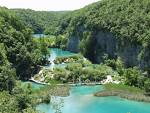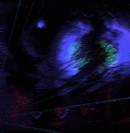See you for FREE !!!!
PLITVICE LAKES - CROATIA
The natural attributes of the Plitvice Lakes National Park, uniqueness and sensibiliry of that phenomenon, deserve a full attention of our visitors. Recreational aspect of stay and the amazement with beauty of the area that conquers by its natural diversity and harmony of shapes and colours  in any of the seasons, is based on many mutually conditioned natural characteristics.
in any of the seasons, is based on many mutually conditioned natural characteristics.
That is a specific geological and hydrogeological phenomenon of karst. The series of 16 bigger and a few smaller lakes, gradually lined up, separated by travertine barriers for which the period of the last ten thousand years was crucial, and which were ruled by ecological relations similar to those of today - suitable for travertine depositing and for the origin of the lakes - are the basic phenomenon of the National Park.
Travertine forming plants, algae and mosses have been and still are playing an important role in their creation, thus making a very sensitive biodynamic system.
Transitive type of climate between coastal and continental with microclimatic diversities makes summer pleasant and sunny, while on the other side winter is relatively long, harsh and snowrich. There are large forestry complexes in the Park area, of which some sections are protected as a special reserve of forestry vegetation due to its primeval characteristics (Corkova uvala virgin forest). Diversity of places and living conditions makes possible for numerous species of plants and animals in watery and terrestrial areas of the Park to develop with no disturbancy.
numerous species of plants and animals in watery and terrestrial areas of the Park to develop with no disturbancy.
It should be stressed that all fundamental things that do determine the Park, make a very fragile structural and functional complex, sensitive to natural changes and to incautious human actions.
UNESCO has declared it with all rights as the World's natural inheritance. All that was mentioned in this short introduction shows a big importance and the reason why this Natural History Guide of The Plitvice Lakes National Park is being published. It should come into hands of every single visitor and draw his attention to numerous attractions of the first Croatian National Park.
 in any of the seasons, is based on many mutually conditioned natural characteristics.
in any of the seasons, is based on many mutually conditioned natural characteristics.That is a specific geological and hydrogeological phenomenon of karst. The series of 16 bigger and a few smaller lakes, gradually lined up, separated by travertine barriers for which the period of the last ten thousand years was crucial, and which were ruled by ecological relations similar to those of today - suitable for travertine depositing and for the origin of the lakes - are the basic phenomenon of the National Park.
Travertine forming plants, algae and mosses have been and still are playing an important role in their creation, thus making a very sensitive biodynamic system.
Transitive type of climate between coastal and continental with microclimatic diversities makes summer pleasant and sunny, while on the other side winter is relatively long, harsh and snowrich. There are large forestry complexes in the Park area, of which some sections are protected as a special reserve of forestry vegetation due to its primeval characteristics (Corkova uvala virgin forest). Diversity of places and living conditions makes possible for
 numerous species of plants and animals in watery and terrestrial areas of the Park to develop with no disturbancy.
numerous species of plants and animals in watery and terrestrial areas of the Park to develop with no disturbancy.It should be stressed that all fundamental things that do determine the Park, make a very fragile structural and functional complex, sensitive to natural changes and to incautious human actions.
UNESCO has declared it with all rights as the World's natural inheritance. All that was mentioned in this short introduction shows a big importance and the reason why this Natural History Guide of The Plitvice Lakes National Park is being published. It should come into hands of every single visitor and draw his attention to numerous attractions of the first Croatian National Park.
After so many millions of regular visitors of this part of Croatia, is it necessary at all to mention their location? The answer is NO to those who know, and YES to all of those who haven't been  there. This large number of visitors from all the continents of our planet Earth is just one of the reasons, but also a confirmation of their exceptional beauty, natural attraction, uniqueness and of that something which can be hardly described by words - that remains only recorded in sound and picture or can be directly felt while being there - to support a not imposed
there. This large number of visitors from all the continents of our planet Earth is just one of the reasons, but also a confirmation of their exceptional beauty, natural attraction, uniqueness and of that something which can be hardly described by words - that remains only recorded in sound and picture or can be directly felt while being there - to support a not imposed wish on us to come back here as soon as we can. One should only let himself to hidden feelings, to complete calmness, to listening to the murmur of waterfalls, while looking at the reflection in the water - in the surrounding where everything moves, changes and is permeated with one harmonious rythm...
wish on us to come back here as soon as we can. One should only let himself to hidden feelings, to complete calmness, to listening to the murmur of waterfalls, while looking at the reflection in the water - in the surrounding where everything moves, changes and is permeated with one harmonious rythm...
Geographically defined: The Lakes are located in the area of southeast Europe, in part of Croatia where we go from northern flat land towards a bit more elevated karsted mountain area. The Lakes are situated where Kordun touches Lika and in the valley Ogulinsko - Plascanska dolina, on the very spring of the karst river Korana - at 480 to 636 meters above the sea level, on the hillside of Mala Kapela and Pljesivica.
 there. This large number of visitors from all the continents of our planet Earth is just one of the reasons, but also a confirmation of their exceptional beauty, natural attraction, uniqueness and of that something which can be hardly described by words - that remains only recorded in sound and picture or can be directly felt while being there - to support a not imposed
there. This large number of visitors from all the continents of our planet Earth is just one of the reasons, but also a confirmation of their exceptional beauty, natural attraction, uniqueness and of that something which can be hardly described by words - that remains only recorded in sound and picture or can be directly felt while being there - to support a not imposed wish on us to come back here as soon as we can. One should only let himself to hidden feelings, to complete calmness, to listening to the murmur of waterfalls, while looking at the reflection in the water - in the surrounding where everything moves, changes and is permeated with one harmonious rythm...
wish on us to come back here as soon as we can. One should only let himself to hidden feelings, to complete calmness, to listening to the murmur of waterfalls, while looking at the reflection in the water - in the surrounding where everything moves, changes and is permeated with one harmonious rythm...Geographically defined: The Lakes are located in the area of southeast Europe, in part of Croatia where we go from northern flat land towards a bit more elevated karsted mountain area. The Lakes are situated where Kordun touches Lika and in the valley Ogulinsko - Plascanska dolina, on the very spring of the karst river Korana - at 480 to 636 meters above the sea level, on the hillside of Mala Kapela and Pljesivica.

THE ROAD DIRECTIONS
The road directions coming from northern side from Varazdin, going through Zagreb and then continuing towards central and southern section of the Adriatic, are bringing us just next to the Plitvice Lakes as well as do the roads coming to them from Kvarner, Gorski Kotar, Slovenia and neighbouring Bosnia and Herzegovina, connecting west with east, or south with north of this part of Croatia. All these directions are connecting tourist attractions of "Primorsko
and then continuing towards central and southern section of the Adriatic, are bringing us just next to the Plitvice Lakes as well as do the roads coming to them from Kvarner, Gorski Kotar, Slovenia and neighbouring Bosnia and Herzegovina, connecting west with east, or south with north of this part of Croatia. All these directions are connecting tourist attractions of "Primorsko  - Adriatic" region with continental area, but visits are varying depending on the season of the year. Respective signs at the border crossings and in all bigger city centres are indicating the location of the Plitvice Lakes and the distance to them. That is why are we always in a position of making decision to go there and stay at the Lakes, either in spring, summer, autumn or winter - taking into account climatic conditions and the time that we have.
- Adriatic" region with continental area, but visits are varying depending on the season of the year. Respective signs at the border crossings and in all bigger city centres are indicating the location of the Plitvice Lakes and the distance to them. That is why are we always in a position of making decision to go there and stay at the Lakes, either in spring, summer, autumn or winter - taking into account climatic conditions and the time that we have.
 and then continuing towards central and southern section of the Adriatic, are bringing us just next to the Plitvice Lakes as well as do the roads coming to them from Kvarner, Gorski Kotar, Slovenia and neighbouring Bosnia and Herzegovina, connecting west with east, or south with north of this part of Croatia. All these directions are connecting tourist attractions of "Primorsko
and then continuing towards central and southern section of the Adriatic, are bringing us just next to the Plitvice Lakes as well as do the roads coming to them from Kvarner, Gorski Kotar, Slovenia and neighbouring Bosnia and Herzegovina, connecting west with east, or south with north of this part of Croatia. All these directions are connecting tourist attractions of "Primorsko  - Adriatic" region with continental area, but visits are varying depending on the season of the year. Respective signs at the border crossings and in all bigger city centres are indicating the location of the Plitvice Lakes and the distance to them. That is why are we always in a position of making decision to go there and stay at the Lakes, either in spring, summer, autumn or winter - taking into account climatic conditions and the time that we have.
- Adriatic" region with continental area, but visits are varying depending on the season of the year. Respective signs at the border crossings and in all bigger city centres are indicating the location of the Plitvice Lakes and the distance to them. That is why are we always in a position of making decision to go there and stay at the Lakes, either in spring, summer, autumn or winter - taking into account climatic conditions and the time that we have.













